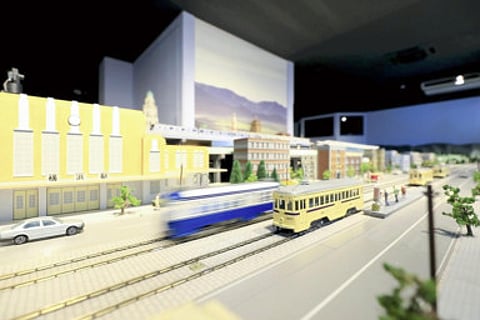Yokohama Tram Museum recalls bygone era
The tram cars have chic wood-finished interiors and are slightly larger than buses

Yokohama, Japan: The first thing you encounter at the Yokohama Tram Museum is seven Yokohama municipal tram cars, each with a conspicuous ad on its front. Such ads were common when the municipal tram network was in service, and the ones in the museum include ads for the weekly magazine Shukan Bunshun and Shin Sankyo drugs.
The tram cars have chic wood-finished interiors and are slightly larger than buses. In some cars, you can push a switch with your foot, producing a sort of “ring ring” sound. Two such bells were the signal for departure, while a single bell indicated the train would stop.
The Yokohama municipal tram system was in service for 68 years through 1972. Known as the “Chin chin train,” it was a key form of transportation for Yokohama citizens. The museum exhibits tram cars and many photos through which visitors can learn about the train’s popularity.
Next to the seven tram cars, there is an area — refurbished in January — about the history of the Yokohama municipal tram.
In 1904, the Yokohama municipal tram began operating between Kanagawa and Oebashi stations, despite opposition from rickshaw men who feared trams would take away customers.
The tram network experienced two major hardships: the Great Kanto Earthquake in 1923 and the Yokohama air raid in 1945. Each event caused massive damage, with half of the tram cars lost in the earthquake and a quarter in the air raid.
The tram was reconstructed and widened later on, reaching its heyday around 1960.
About 300,000 people used the tram daily then, and its network expanded throughout the city into such areas as the Kannai business district and the Isezaki downtown area. The Sakuragicho district served as the central hub.
Although the municipal tram overcame great setbacks such as the 1923 earthquake and the Second World War, it could not compete with automobiles and the national railway.
Along with the spread of private cars, it became impossible to operate the tram on schedule due to traffic jams. The now-defunct Japan National Railways also opened the more convenient Negishi Line, all of which led to the tram service being shut down in 1972.
Even people who never rode the tram themselves will likely feel nostalgic when they see a notice on a wall that says, “Thank you for riding” and a photo in which a tram decorated with flowers is surrounded by members of the public and station officers saying farewell to the tram.
The history of the tram overlaps with that of Yokohama itself.
“The number of people who rode on the trams themselves will continue to fall,” said Kazuo Ito, director of the museum. “I hope many children will visit the museum.”
Sign up for the Daily Briefing
Get the latest news and updates straight to your inbox


